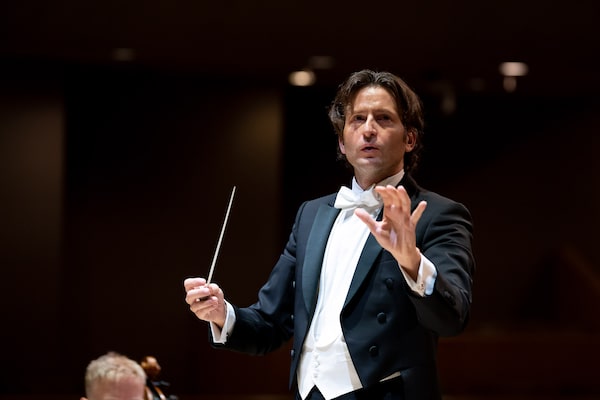The Superfan: Ted Kulczycky
Ted Kulczycky, a Talking Heads super fan, has loved their concert film Stop Making Sense since he first saw it in 1985.Melissa Tait/The Globe and Mail
There are fans, and then there are fans, and then there is Ted Kulczycky.
A day before tickets went on sale for the world premiere of a new 4K restoration of the 1984 Talking Heads documentary Stop Making Sense at the Toronto International Film Festival, the world’s biggest fan of the movie was run over by car as he stepped off a streetcar. Among other bones, his neck was fractured.
One of the 53-year-old librarian’s first thoughts upon regaining consciousness in his hospital bed was to arrange for the purchasing of a seat to the screening. He couldn’t do it himself, as his thumb was broken. It was one of the festival’s toughest tickets – the four former band members would temporarily reunite to attend the screening.
Kulczycky had seen the Jonathan Demme acclaimed rock doc more than 80 times in theatres since first watching it as a teenager in 1985. But he had never been in the same room with the band, as the group never again toured after the Stop Making Sense tour. The experience of seeing them together at TIFF would be, as it were, once in a lifetime.
He got the ticket. But there was a problem: He was so battered from the accident there was no guarantee he would be mobile enough to attend the screening, which was less than three weeks away. “When a physiotherapist asked me if wanted to try standing, I told him I would,” he told The Globe and Mail later. “I knew the sooner I stand, the more likely it was that I was going to be allowed to go to this movie.”
In a wheelchair and wearing a neck brace, he made it to the premiere.
In 1984, film critic Roger Ebert wrote that the overwhelming impression throughout Stop Making Sense was of “enormous energy, of life being lived at a joyous high.” Kulczycky is no nerd or fanboy. A former philosophy student, he has studied the film intensely and thoughtfully. He finds in it high joy and meaning. For his dedication to a piece of art, he deserves two thumbs up.
The Mainstays: Toronto Symphony Orchestra

Gustavo Gimeno conducts a TSO dress rehearsal.Stuart Lowe/TSO
When a 93-piece orchestra toots its own horn, much noise is made.
In 2023, the Toronto Symphony Orchestra continued a 100th-anniversary season that kicked off late the year before with a concert featuring four former TSO music directors and the current one, Gustavo Gimeno. One could not swing a baton that night without hitting a maestro.
The party accelerated this year, starting with the TSO’s first tour with Gimeno, at concerts in Ottawa, Chicago and New York. At Carnegie Hall, Samy Moussa’s Symphony No. 2, a TSO commission from the Montreal composer, made its U.S. premiere.
There’s no place like home, though, ancestral homes included. On Feb. 17, the TSO returned to its old stomping grounds at Massey Hall in Toronto. That is where, on April 23, 1923, the orchestra gave an inaugural performance that included a rendering of Tchaikovsky’s Symphony No. 5, a piece reprised there this year.
A world-class orchestra entertains – you don’t need Chuck Berry or Tchaikovsky to tell you that news. But it also stands as a constant in a world of upheavals. A symphony’s hall is a place of tradition, classics and ritual communion.
This fall, days before it was scheduled to start its season, the Kitchener-Waterloo Symphony declared bankruptcy. Sometimes the band does not play on. One hundred years of the TSO demanded all the trumpeting the accomplishment received.
The Classic-Rock Interpreter: Elisapie

Québécoise singer-songwriter Elisapie released an album of classic-rock cover songs sung in Inuktitut.Leeor Wild/Handout
How far is it from California to Californiamut? The trip took an Inuk musician more than 30 years to make.
She is Elisapie, a Québécoise singer-songwriter who released an album (Inuktitut) of classic-rock cover songs sung in Inuktitut. Her elegant and emotionally charged interpretations of Metallica’s The Unforgiven, Pink Floyd’s Wish You Were Here, Cyndi Lauper’s Time After Time, Led Zeppelin’s Going to California and other pop and rock classics represent a cathartic journey for her.
“I cried a lot making this album,” the Juno winner told The Globe and Mail. “What I am trying to bring back with these songs is my childhood – the sound and the energy there was, and also the sadness I felt. And it’s not just about the songs. It’s a whole other world.”
Elisapie came of age in the fly-in Inuit community of Salluit. There she grieved the suicides of cousins, experienced young love, witnessed the effects of colonialism and danced at the village community centre.
“The songs of Led Zeppelin and the Rolling Stones were made by white people, but we felt safe around their music,” she explained. “Led Zeppelin was a friend to my uncle, a residential-school kid feeling lost. He had Zeppelin to listen to, just as Metallica was a friend to me and my cousins.”
Inuktitut speaks to the universality and power of music, presented gracefully and nostalgia-free. As the song goes, “They say she plays guitar and cries and sings, la-la-la.” And, of course, la-la-la needs no translation.
Dolly Parton’s covers album Rockstar may have gotten more headlines, but Elisapie truly rocked 2023.
The Bobblehead Model: Yannick Nézet-Séguin

During Philly Loves Yannick Week, a bobblehead novelty figurine in Yannick Nézet-Séguin's image was unveiled.Courtesy of The Philadelphia Orchestra and Kimmel Center
Leonard Bernstein never had his own bobblehead.
But Yannick Nézet-Séguin, the 48-year-old maestro and native Montrealer who dominated in 2023, does. The music director of New York’s Metropolitan Opera and the principal conductor and music director of his hometown Metropolitan Orchestra signed a contract extension this year with Philadelphia Orchestra that will keep him employed in that city through 2030, and expand his title from music director to music and artistic director.
Philadelphia slathered love on Nézet-Séguin like cheese on steak. During Philly Loves Yannick Week, a bobblehead novelty figurine in his spiffy image was unveiled.
If the baton-waving charmer wasn’t busy enough, he found time to serve as the consultant on the new Netflix Leonard Bernstein biopic, Maestro. The famous Philadelphian Bradley Cooper is the star and director of the film. Bernstein has a history with Philly: He trained at the Curtis Institute of Music and appeared with the city’s orchestra a dozen times between 1948 and 1979.
And while Bernstein’s 16 Grammy Awards dwarf Nézet-Séguin’s three, one of the latter’s was for his own musical performance in 2023 (as a pianist, for Voice Of Nature – The Anthropocene, with soprano Renée Fleming). Bernstein never won for playing. - BRAD WHEELER
The Centenarian: Françoise Sullivan
Françoise Sullivan in front of her artwork at Galerie de l'UQAM in Montreal on May 10.Stephanie Foden/The Globe and Mail
In 1948, she signed the Refus Global, the document that launched Quebec’s Quiet Revolution. In 2023, she celebrated her 100th birthday in June and unveiled an exhibition of new paintings at the Montreal Museum of Fine Arts in November.
A central cog in Quebec’s contemporary art scene, Françoise Sullivan has never stopped ticking.
Born into a bilingual middle-class Montreal family in 1923, she was a young dancer and visual artist pursuing a career in New York when she returned to Montreal in the summer of 1948. Her pals in the Automatiste movement, led by art teacher and painter Paul-Émile Borduas, were ready to take a stand against Quebec’s stultifying religiosity and conservative politics. Sullivan’s father was appalled, but nonetheless she signed Borduas’s manifesto declaring the importance of unbridled creativity. She even contributed an essay, La danse et l’espoir (Dance and Hope).
Today, Sullivan and designer Madeleine Arbour, another centenarian, are the last two of the 16 signatories still alive, while co-signer Jean-Paul Riopelle would also have turned 100 this year. A few months before they made that historic gesture, Riopelle filmed Sullivan dancing in the snow at the base of Mont Saint-Hilaire, creating a film, Danse dans la neige, that remains a seminal work of mid-century surrealism.
Sullivan settled in Montreal, working as a choreographer for television with Radio Canada and then, in the 1960s, turning her hand to sculpture and winning acclaim for mighty geometric constructions in brightly painted steel. With long stints in Italy in the 1970s, she also worked as an experimental filmmaker and a conceptual artist, continually reinventing and updating her career to remain a lively practitioner and much-loved teacher.
Since the 1980s, she has mainly painted, abstract and semi-abstract geometric canvases in strong colours. “She has a very direct and fresh outlook,” said MMFA director Stéphane Aquin of her latest work. “It’s in keeping with the Automatiste spirit. She doesn’t come to painting doing 20 preparatory drawings. She just goes for it. They are very candid, very fresh and very direct. There is no second guessing.” - KATE TAYLOR
The Risk-Takers: Matt Johnson & Matthew Miller
Director Matt Johnson at the Grand Hyatt Hotel in Berlin on Feb. 17, ahead of the world premiere of the Canadian film Blackberry.Joel Ryan/The Globe and Mail
As brash and bold and unapologetically Canadian as the Waterloo, Ont., company it follows, this year’s riotous comedy BlackBerry will go down in the books as one of this country’s most successful cinematic gambles. And if there is justice in the Canadian film world (ha!), the daredevils responsible for the film, writer-director-star Matt Johnson and writer-producer Matthew Miller, should go on to turn the industry inside out.
Like the pair’s previous projects – the pseudo-slacker Viceland series Nirvanna the Band the Show, the dark feature films The Dirties and Operation Avalanche, even their kids cartoon Matt & Bird Break Loose – BlackBerry delivers a fiery kind of controlled chaos that is impossible to resist. Breaking every Canadian film rule while establishing new ones, Johnson and Miller have made the kind of movie that should inspire an entirely new generation of restless storytellers.
Watch out for the two Matts as they continue to push and challenge the system in all the right ways for years to come. Waterloo Vampires 4VR, baby.
The Master of Shtick: Nathan Fielder
Nathan Fielder as Asher in Season 1 of The Curse.Beth Garrabrant/Paramount+
It has become increasingly difficult to tell when the shtick starts and stops for Nathan Fielder. The Canadian comedian, who got his start with deadpan bits on CBC’s This Hour Has 22 Minutes, has steadily become the new face of Hollywood cringe comedy thanks to his series Nathan for You and last year’s HBO sensation The Rehearsal.
But with this past fall’s Showtime/Paramount+ series The Curse, Fielder has graduated to a new level of is-he-serious provocation. A hall-of-mirrors send-up of reality television, with a heaping dose of skepticism when it comes to gentrification and faux-progressive culture, Fielder’s show is both so deeply unnerving and hilarious that it’s almost sinister. I’m legitimately scared of what he might cook up for 2024.
The Most Ken-adian: Ryan Gosling

Ryan Gosling's Ken revealed new comedic depths to the actor’s talents, writes Barry Hertz.Courtesy of Warner Bros. Pictures/Warner Bros.
Son of a beach, he did it: In Barbie, Ryan Gosling gave one of the greatest performances of the year, delivering a Ken that revealed new comedic depths to the actor’s talents, while also channelling a highly specific riff on Southern Ontario bros that could only be conjured by a true Canadian. In an era where the film industry is undergoing a leading-man crisis – unless they’re strapped in spandex, does anyone much care what the Hollywood Chrises do on-screen? – Gosling has consistently reminded audiences of the power of true movie-star charisma. - BARRY HERTZ
The Conversation Starter: Pablo Rodriguez and Bill C-11
Minister of Transport Pablo Rodriguez rises during question period in the House of Commons on Parliament Hill in Ottawa on Dec. 11.Sean Kilpatrick/The Canadian Press
Just about everyone with skin in the game is angry with the Online Streaming Act. Maybe that’s a good thing. Three-quarters of a century after the Massey Commission and 50-odd years into the CanCon era, it’s long past time to rethink what it means to promote and sustain Canadian culture for the digital age. Canadian artists in the screen and music sectors deserve certainty in how they’ll be supported in an online ecosystem that is both borderless and dominated by (primarily) American distribution systems.
Though erstwhile heritage minister Pablo Rodriguez is no longer in charge of the file, he shouldered the weight of our national infighting before Bill C-11 passed last spring. He’s now handed the file to his successor, noted former indie-rock bassist Pascale St-Onge, as the Canadian Radio-television and Telecommunications Commission figures out the new law’s regulatory shape.
Rodriguez is probably viewed more often as a villain than a hero by the many executives and their lobbyists who spent a lot of time and money trying to convince Ottawa (and creators) to shape Bill C-11 in ways that benefited their bottom lines. And let’s be honest: The minister really didn’t do himself any favours shooting down a Senate amendment that would have confirmed the legislation wouldn’t apply to everyday Canadians’ uploads to services such as YouTube.
It is yet to be seen exactly how heavy-handed the new regulations will be. But the final policy direction issued by St-Onge’s office in November insists on flexibility and adaptability. The CRTC is now required to “prioritize its examination” of how it defines “Canadian programs” as it seeks a regulatory environment “where web giants contribute to the creation and promotion of Canadian stories and music.” (The policy direction says the CRTC should exclude social-media content, but also content by “digital creators.” This ambiguous term could be wielded to blur the line between professionals and consumers and will no doubt cause more anger over whose content faces regulation.)
Goodness knows there’s more fighting to come. But it’s a conversation we need to have to keep Canadian culture healthy. - JOSH O’KANE
The Laugh Maker: Mae Martin

Mae Martin speaks onstage during Laugh Out Loud with Mae Martin and Friends hosted by Netflix at TUDUM Theater in Hollywood, Calif.m on March 28.Tommaso Boddi/Getty Images
Mae Martin came home this year the conquering Canadian comedian.
After building up their career as a funny person in Britain for a decade, including two seasons of the groundbreaking Channel 4/Netflix comedy-drama Feel Good, Martin chose the Vogue Theatre in Vancouver to film their first hour-long stand-up special for Netflix.
SAP, as Martin’s streaming set was called, was shot on a suitably outdoorsy set – and was as sweetly Canadian as pouring maple syrup all over a radio playing Stuart McLean. Indeed, a key story told involves the question of whether a moose could exist large enough for a small car to drive underneath. (Apparently, yes!)
The special was also an avenue for the inordinately affable Martin to talk about their troubled teen years in Toronto, about addiction and recovery – and about how having top surgery and starting on testosterone has led to the best year of their life: “It’s truly just like, the absence of agony, that’s all it is.”
In their endearing act, Martin talks about gender at the end because, they say, “everyone else is” – throwing a few gentle jibes at Netflix-partnered colleagues such as Dave Chappelle and Ricky Gervais, who have built punchlines around trans and non-binary people. “I watch those specials so I can be informed when I am asked in every interview to talk about those guys’ specials,” Martin jokes.
Otherwise, Martin was the consummate team player in the comedy scene here and abroad – winning Season 15 of Taskmaster, the Channel 4 comics-in-competition series, in the U.K., and launching Handsome, a charming conversational podcast with Americans Tig Notaro and Fortune Feimster, which was visited by heavy-hitters such as Jimmy Fallon and Sarah Silverman.
A former member of the Baroness Von Sketch Show writer’s room, Martin also notably showed up on screen in Crave’s I Have Nothing, Carolyn Taylor’s cringe-then-feel-good docu-comedy series about her foray into figure skating choreography. Martin was the perfect straight man – comedically speaking – to Taylor’s inspired kookiness on the best new Canadian comedy series of the year.
The Chekhov-challenger (and Ukraine-booster): Andrew Kushnir

Beyond his Ukraine-focused art and activism, Andrew Kushnir also emerged as one of Ontario’s top directors this season.Handout
On the first anniversary of Vladimir Putin’s full-scale invasion of Ukraine last February, Andrew Kushnir, a queer Ukrainian-Canadian playwright, director and activist, penned an article for the theatre website Intermission that asked a simple but provocative question: “Why is Canadian theatre so Russian right now?”
This was more than just a call-out of the four Toronto companies that had somehow all decided to centre the work of Anton Chekhov in their seasons as Russia’s attack on Ukraine, the biggest war in Europe since 1945 and with so much in the balance, grinded on.
Kushnir’s article was an invitation to think about continuing Russian cultural imperialism, about the questionable aesthetic of “placelessness” in classical theatre and about the strange absence of Ukrainian stories on Canadian stages even though Canada is home to that country’s second-largest diaspora.
As such artistic conversation starters should ideally do, Kushnir’s intervention led to increased breadth of what was seen on Canadian stages this year, rather than cancellations.
Notably, Bad Roads, a drama by Ukrainian Natal’ya Vorozhbit that provided uncensored snapshots from the front lines of the beginning of the Russia/Ukraine conflict in 2014, ended up having its disturbing North American premiere at Toronto’s Crow’s Theatre in November under the direction of Kushnir himself.
For the Stratford Festival, Kushnir curated a series of readings called Encountering Ukraine, introducing audiences to a century of dramatic voices from the country as well as short plays that have been written since 2022.
Meanwhile, The Division, Kushnir’s own play inspired by a 2019 trip to where his grandfather was born in Ukraine, had a reading at the Lincoln Center in New York as part of the Criminal Queerness Festival.
Off-stage, Kushnir continued his direct activism for the We Support LGBTQ Ukraine Fund, which he started in the summer of 2022 in partnership with the Veritas Foundation and which now has raised more than $130,000.
(In a show of theatrical solidarity, that fund was augmented in part by merch sold on a cross-country tour of Punctuate! Theatre’s First Métis Man of Odesa, Matthew MacKenzie and Mariya Khomutova’s personal dramatic dispatch about lives upended in Canada and Ukraine by the Russian invasion.)
Beyond his Ukraine-focused art and activism, Kushnir also emerged as one of Ontario’s top directors this season – with his moving production of Nick Green’s Casey and Diana, a Canadian history play about the AIDS crisis, now available to stream on Stratfest@Home and back on stage at Soulpepper in January.
The Emotional Exiter: Karl Tremblay

A photo and flowers on the stage during an event paying tribute to the late Karl Tremblay, lead singer with Les Cowboys Fringants, in Montreal, on Nov. 28.Graham Hughes/The Canadian Press
The singer of Les Cowboys Fringants did not go gentle into that good night – but rocked against the dying of the light.
In 2022, Karl Tremblay – the voice of an iconic néo-trad band behind many an unofficial anthem of Quebec – publicly revealed his diagnosis with prostate cancer.
But while 2023 was marked by many cancelled dates, among the appearances Tremblay’s band did make was an emotional one at the Plains of Abraham in July. It has already gone down in Québécois cultural history, compared to the legendary appearance of Gilles Vigneault, Félix Leclerc and Robert Charlebois on the same site in 1974.
The performance nearly didn’t happen – on its originally scheduled day at the Festival d’été de Québec, a sudden violent storm came in, cutting short a set by just Charlebois (still on stage at 79 years old) that was meant to precede Les Cowboys Fringants’.
But the festival made the decision to extend to Monday – drawing back an audience of 90,000 on a week night for a love-in during which they helped Tremblay sing his band’s moving 2019 song about leaning on one another when help is needed, Sur mon épaule (On My Shoulder).
As The Globe and Mail’s Frédérik-Xavier Duhamel wrote, revisiting the moment: “Now grey-bearded, tired from cancer treatments and sitting onstage wearing his signature black shirt and bright tie, Mr. Tremblay was visibly moved as the crowd hugged him with its collective voice.”
Tremblay, whose place in Quebec culture has been compared to that of the late Gord Downie in the rest of Canada, made his very final appearance on stage on Oct. 3 – in a more intimate show where he was still giving the finger to cancer. Literally: In a photo that Jean-François Pauzé, who wrote most of the lyrics for Les Cowboys Fringants songs that Tremblay brought to relatable life, shared on Instagram, the everyman singer can be seen sitting in a chair flipping the bird with both hands.
Tremblay died on Nov. 15 – a final spectacle came in the form of his national funeral later that month at the Bell Centre in Montreal. “The first thing we’re afraid of forgetting when someone dies is their voice,” said Marie-Annick Lépine, Tremblay’s bandmate and life partner, as translated in the Montreal Gazette. “But I think we’ll still be hearing yours for a long time.”- J. KELLY NESTRUCK
The Storyteller: Jennifer Podemski
Jennifer Podemski produced Little Bird, her most personal work yet, in 2023.Mark Blinch/Globe and Mail
Jennifer Podemski has been at this since she was 17, as an actor, writer, director and producer in television and film, including Dance Me Outside, Empire of Dirt and Reservation Dogs – telling the stories of her people amid the polyglot that is Canada, and helping her non-Indigenous co-creators not screw up the facts. But this year, she produced her most personal work yet: Little Bird, a harrowing but hopeful four-part Crave/APTN series. As a child, the title character is kidnapped from her Saskatchewan home in the Sixties Scoop and adopted into a Jewish family in Montreal (who rename her Esther); as an adult, she embarks on quest to reclaim her shattered family.
Too few Canadians know about the Scoop, and too much of Esther’s story echoes in Podemski’s life: Her father is Jewish, her mother Anishinaabe; her grandfather was a Holocaust survivor; she saw her mother alienated within her father’s culture; and she’s struggled with her two identities. Most chillingly, she was taken at birth from her 17-year-old unwed mother. Thankfully, her mother got her back after a few months with the help of a social worker who was about to retire (perhaps atoning for past mistakes).
Developing, writing and shooting Little Bird was “a brutal, traumatizing experience,” Podemski said earlier this year. It forced her to make personal connections to survivors, to hear stories of the worst kind of violence and abuse, and to realize that these are her kin. And not just in history, in current reality. “It brought up a lot of stuff,” she said. “But this is the work I do. It’s my purpose.”
Podemski planned to stop working when she felt there was a critical mass of Indigenous women in front of and behind the camera, but she’s not there yet – of the content creators who receive Canadian funding, less than 1 per cent are from that cohort. So in 2020, she founded the Shine Network Institute, a non-profit dedicated to celebrating Indigenous women in media through training and mentorship.
If someone hired her to run a show about an entirely non-Indigenous thing, with a non-Indigenous cast and crew, Podemski doesn’t know if she’d be able to do it and still sleep at night. But, she adds pointedly, she’s never been asked.
The Director: Chelsea McMullan

Chelsea McMullan attends the Swan Song premiere during the 2023 Toronto International Film Festival at Roy Thomson Hall on Sept. 9.Robin L Marshall/Getty Images
Chelsea McMullan is the best director in Canada at doing a notoriously difficult thing: capturing the essence of live performance in cinema. In the documentary Ever Deadly, McMullan (they/them) doesn’t simply film a sustained concert by the Inuk throat singer Tanya Tagaq – they turn viewers into the microphone, and the beads of sweat that roll down Tagaq’s cheeks, and the lights that blur behind her, and the trance she puts herself into. In Crystal Pite: Angels’ Atlas, McMullan first takes us behind the scenes to understand Pite’s creative process, and then puts us on the stage, amid the bodies, inside the dance itself.
This year McMullan outdid themselves. They preserved for posterity the debut of Karen Kain, Canada’s foremost ballerina, directing Swan Lake, the ballet that made her famous, by creating a four-part limited series, Swan Song, that is itself a piece of art. They also cut a shimmering two-hour film version. It asks probably the biggest question of an artist: How much stress, physical suffering and emotional turmoil is “worth it,” and how much is too much?
Swan Song wouldn’t have worked if McMullan and their crew didn’t give as much of themselves as Kain and her dancers did. They preinterviewed 70 members of the company, finessed permission from five unions and gained the trust of camera-averse artists in a notoriously protective art form. They shot with two cameras, five days a week, 10 hours a day, monitoring sound from seven audio channels, running alongside the dancers – miraculously, without getting in their way. They even got the regal Kain to let her hair down – a bit. The result is a joyous, alarming, thrilling trip deep into the language and process of dance. It affirms McMullan’s expertise as an artists’ director – and an artist. - JOHANNA SCHNELLER
Sign up for The Globe’s arts and lifestyle newsletters for more news, columns and advice in your inbox.
 Barry Hertz
Barry Hertz Brad Wheeler
Brad Wheeler Josh O’Kane
Josh O’Kane Johanna Schneller
Johanna Schneller Kate Taylor
Kate Taylor J. Kelly Nestruck
J. Kelly Nestruck